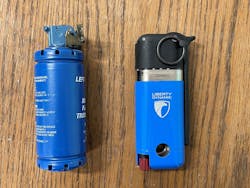Controlling the Reform Message
No matter where you live in the country today, you’ve heard the widespread cry for “law enforcement reform.” In almost every case, the “reform” demand is either from the surviving family of a violent suspect/criminal who died during an arrest or from the mainstream media who is creating sensationalistic hype that will, in turn, create more ‘news’ for them to report. Both situations depend on two assumptions.
The first assumption is that all law enforcement operations and officers are inherently evil and need to be better controlled. The second assumption is that any reform of value must limit what law enforcement officers are allowed to do, how they can be armed, etc. Both assumptions press the belief that any “meaningful reform” must further leash the men and women in uniform as they risk their lives and sacrifice to protect and serve their communities.
Our challenge is to take control of the reform message; to push back against the false assumptions; to counter an effort that will ultimately only increase the crime rates across our nation. While some might think this would take huge budget dollars or a completely new way of doing business, reality is that it only requires us to increase our communication efforts, most especially on social media. Why? Because we already reform how we do business in an on-going basis. We reform at least annually, if not quarterly. We constantly update how we perform our duties and how our agencies are run. What we need to do is package the information about such for public consumption and then push the message out. If you’re reading this and wondering what reform is being done regularly, let’s look at a couple examples of ‘common reform’ and then an example of targeted reform.
Every year, law enforcement officers across the nation change how they perform their duties. The changes made are based on a variety of topics that drive reform. Every officer in the nation is required to attend in-service training. The training materials can include any topic covered in the academy, any new material attached to related tools or tactics, any new material attached to new case law as generated by court decisions and more. Sometimes the new material is based on changes in policy related to minimizing or mitigating insurance liability. Sometimes the new material is related to new patrol procedures, information equipment use, etc.
Such training inevitably changes something in how an officer does his job. That change is REFORM. Again, this reform is done at least annually as all officers are required to attend in-service training once a year (at a minimum). In some states (Maryland is the example), some topics are mandated on a regular basis because there is such regular change in the attached topic or the laws pertaining to it. Investigating sex crimes is the example I’ll use. Domestic Violence response is another. If we know that our performance protocols attached to those topics change so regularly as to mandate regular training updates, then why aren’t we presenting those changes as reform?
The answer is simple: we’ve never had to and now we’re behind the curve. The mainstream media and every pundit on social media is now screaming for reform and to defend their position, law enforcement agencies have to be able to demonstrate what they’re doing to reform. The politicians controlling the purse strings are demanding it. The citizens who elect those politicians are demanding it. The citizens who elect Sheriffs are demanding it. What all of those people don’t understand, because we haven’t made the effort to educate them about it, is that we constantly reform.
The example of targeted reform I’ll give you has to do with special operations tools. Anyone has been trained for a SWAT team knows what a distraction device, more commonly called a ‘flash-bang,’ is. Traditional flash-bangs were cylindrical devices with a lever or “spoon” and a safety pin. Like a grenade, you pulled the pin and tossed the device into a room. The spring-loaded lever would pop off and the timed fuse would activate the device after a preset number of seconds. Even non-law-enforcement officers have seen this done hundreds of times in movies.
There were a few challenges with the traditional flash-bang though. It sometimes rolled past the intended deployment point. It could produce temperatures that might start fires or injure people in too close of proximity. Very rarely something would break and it would produce shrapnel. Still, it was an invaluable tool used during a dynamic entry to buy the entry officers a second or two of time wherein suspects were not resistive and could be more easily arrested. That recognized, we in law enforcement still recognized the risks built into use and trained to avoid causing any injury or damage. We could not mitigate that risk 100%.
Enter a company called Liberty Dynamic. Owned and operated by men who had used traditional distraction devices extensively during their careers, Liberty Dynamic designed and produced a distraction device that alleviated the risks associated with traditional flash-bangs. The Liberty Dynamic device isn’t cylindrical, but instead is rectangular. The fact that it’s not round prevents it from rolling into unintended places. It still has a pin and a lever and a preset timed fuse, but what causes both the sound and light is a reloadable binary fuel charge. The device does not “burn hot,” and can be picked up immediately after use. As such, the chances of it ever starting a fire upon discharge is minimal if not non-existent. There is no way for shrapnel to be created when the device is deployed.
Now, here’s the reform message and what our communities need to have communicated to them: Nothing is mandating a change from traditional flash-bangs to this new Liberty Dynamic device. However, because the agency is committed to minimizing all risk to life and property, even during high-risk operations, they make the change to this new device. Yes, there is an expense, but it’s quickly offset by the reduced liability of avoided damages and potential injury. Distraction devices would have to be purchased for replacement anyway, so the budgetary concerns are really non-existent.
What’s the overall message? Because the agency places such a high regard on the life and property of all citizens served, even those living outside the law, it is making an equipment change to insure absolute minimal risk even during high-risk operations. This proactive reform on the part of the special operations team/division, is specifically being accomplished to protect citizens and their property.
So, take a look at what your agency is training this year. Take a look at what equipment changes you’re making. Consider the public relations message and identify what your agency is doing in the way of proactive reform. Then develop a clear message to communicate that to your community and use every communications outlet available to push that message out.
About the Author
Lt. Frank Borelli (ret), Editorial Director
Editorial Director
Lt. Frank Borelli is the Editorial Director for the Officer Media Group. Frank brings 20+ years of writing and editing experience in addition to 40 years of law enforcement operations, administration and training experience to the team.
Frank has had numerous books published which are available on Amazon.com, BarnesAndNoble.com, and other major retail outlets.
If you have any comments or questions, you can contact him via email at [email protected].

